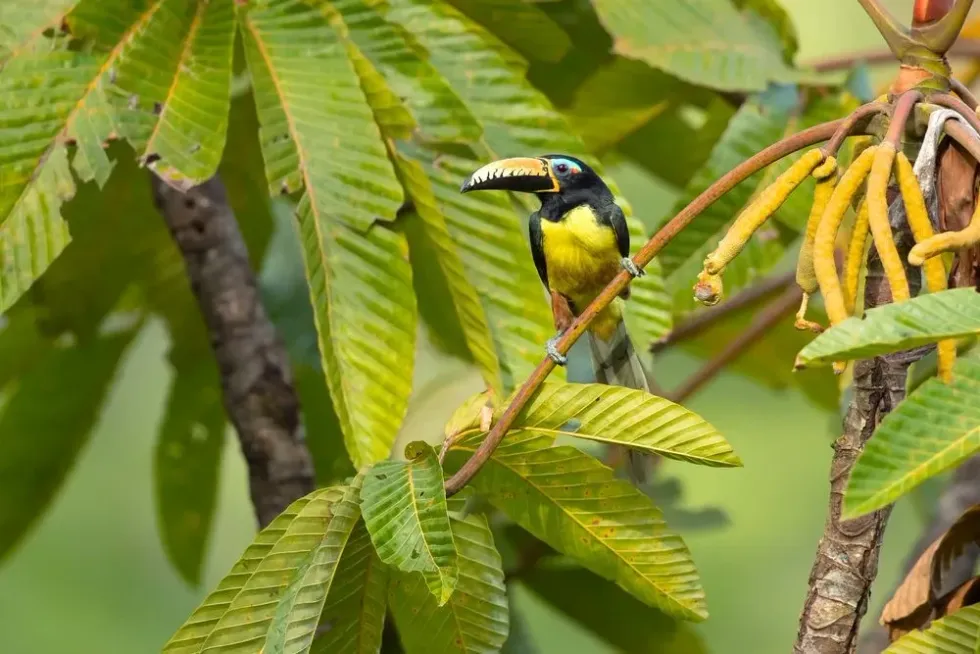The lettered aracari (scientifically known as Pteroglossus inscriptus) is a medium-sized toucan bird found in the forests of South America including Bolivia, Colombia, Peru, Ecuador, and Brazil.
As one of the smaller members of the toucan and barbet family (Ramphastidae), this bird species weighs 4.6 oz (130 g) and has an average length of 11.5 in (29.2 cm). They are easily recognizable for their oversized yellow bill, which is marked with a row of short black lines (or letters) and a black mandible.
Although they are predominantly black, they have a very colorful plumage with yellow underpart and blue around their eyes, small dark wings, and long dark tails.
Read on for more facts and check our similar articles about the black-capped gnatcatcher and carrion crow.
Lettered Aracari Interesting Facts
What type of animal is a lettered aracari?
The lettered aracari (Pteroglossus inscriptus) is a medium-size toucan bird.
What class of animal does a lettered aracari belong to?
The lettered aracari belongs to the Aves class of birds and a type of toucan bird.
How many lettered aracaris are there in the world?
The exact population size of this bird in the world is unknown. There are two known subspecies; a larger Humboldt’s lettered aracari (P. I. humboldti) is found in Colombia, Brazil, Bolivia, Ecuador, and Peru. The smaller, P. i. inscriptus found is from North Central Brazil to eastern Bolivia.
Where does a lettered aracari live?
The lettered aracari (Pteroglossus inscriptus) lives in lowland forests and the foothills of the Andes of South America. References indicate they can be found in large range across Colombia, Ecuador, Bolivia, Peru, and Brazil.
What is a lettered aracari's habitat?
The lettered aracari toucan primarily lives in subtropical and tropical habitats found in moist lowland forests and swamps of South America. These toucans are in large ranges throughout Bolivia, Colombia, Ecuador, and Peru.
When they are not foraging in fruit trees, or scavenging for more food on the ground, these birds will often be seen perched on a snag in the forest.
Who do lettered aracaris live with?
Aracaris are gregarious and will generally roost socially throughout non-breeding seasons. It has been discovered that up to five adult birds and their offspring, will share a single nest. A nest such as this is typically found in the canopy of a lowland forest in pairs and small groups.
How long does a lettered aracari live?
The lettered aracari toucan has an average lifespan of 14-18 years. Their median life expectancy differs across their main life stage for example from hatching, this average is 3.8 years for males and 4.5 for females. From fledging, the median life expectancy extends to 5.9 years for males and 6.2 years for females.
How do they reproduce?
Of what little information is known about the breeding patterns of the lettered aracari (Pteroglossus inscriptus), breeding seasons are believed to occur in Western Amazonia between December and July and from August to March in Eastern Brazil. Once they find a pair, a suitable nest location will usually found in empty tree hollows usually high in the forest.
These hollows provide a safe and discrete breeding area for eggs and nestlings.
Both parents will share the incubation of the eggs as well as parental duties. Incubation will usually take 16 days, with the average clutch size undergoing incubation in a range between two to four.
Once hatched, the chicks are very fragile as they are born blind and will be protected and fed by the parents as well as other adults (potentially offspring) for six weeks.
Young are born with thick padded heels that will protect their fragile feet and legs from the rough debris within the nest. Even after leaving the nest, parents will continue the behavior of feeding their offspring for several weeks.
What is their conservation status?
These toucans are listed as Least Concern on the BirdLife International list. Although their population is in decline, they still have a large range in South America so the rate of this population trend is yet to meet the vulnerable criteria.
Lettered Aracari Fun Facts
What do lettered aracaris look like?
Lettered aracaris (Pteroglossus inscriptus) are an exotic species of toucans found in South America. They are easily identified by their large yellow bill (or beak), the color of their plumage consisting of a yellow underpart, blue areas around their eyes, and long dark tails.
They have very short but strong legs, with relatively small wings, and they weigh a mere 4.6 oz (130 g). The genders within this species have different colored faces, the female's face is a chestnut color, whilst males have black faces.
Their most distinctive feature is the marked row of short black lines (or letters) on their beak. The two subspecies are primarily black, green, and yellow in color.

*Please note that this is an image of a chestnut-eared aracari, not a lettered aracari. If you have an image of a lettered aracari, please let us know at hello@kidadl.com
How cute are they?
The disproportion of their features, including their large yellow bill, small body, small wings, long tail, and bright colors, makes the lettered aracari one of the more fascinating toucans in the world.
How do they communicate?
Toucans are known for their unique communications behavior incorporating a variety of 'repeated shill yelps'. Just like other members of the aracaris (genus Pteroglossus) family, lettered aracaris have their own distinctive vocalizations that are identifiable in their forest habitat. Their sounds are often described as 'electric grunts' and 'guttural cha' notes.
How big is a lettered aracari?
The lettered aracari (Pteroglossus inscriptus) is one of the smallest birds in the aracari (medium size toucan) species. Despite its large oversized bill, adults are very small in size at just 4.6 oz (130 g) with an average length (including their long black tail) of 11.5 in (29.2 cm).
By description, the body of this aracari is one-third smaller than the black-necked aracari (one of the largest in the toucan family).
How fast can a lettered aracari fly?
Lettered aracari's like other members of the aracari (medium-sized toucan) family are surprisingly fast birds. Although they have relatively small wings, they very have a very light-weight but strong skeleton, making them very agile birds once in flight.
How much does a lettered aracari weigh?
This aracari weighs 4.6 oz (130 g) and is considered medium-size in comparison to other toucans.
What are the male and female names of the species?
The names for male and female lettered aracari are simply female and male lettered aracari.
What would you call a baby lettered aracari?
The young offspring of lettered aracari are called chicks.
What do they eat?
Lettered aracaris have a diet of fruits, insects like grasshoppers, and nestlings of small birds such as swallows and finches. Their large beak is advantageous in many ways, including finding their food. In the forest, it allows them to easily gather food from tree holes as well as steal from the nests of small birds.
Are they poisonous?
These toucans are not poisonous.
Would they make a good pet?
Aracaris can be kept as pets, however, unlike cats and dogs, they are not domestic animals and will take considerable upkeep.
For example, green aracaris (another type of aracari) can be a very charming pet, but in comparison to the average bird, it can be more expensive to set up and maintain.
Toucans are habituated to the open forest, so there will need to be enough area for them to move around freely, whether that is flying indoors or moving from branch to branch within man-made housing.
They are also noisy birds, so their unique vocalizations might also be more than the average bird owner can tolerate.
Did you know...
Although there is a range of 43 species of toucans, toucanets, and aracaris in the family Ramphastidae, there are only 14 species in the Pteroglossus (Aracari) genus found all over the world, many in the Amazon basin. They are typically green, black, and yellow in color.
The black markings on their beak are referred to as 'letters' which is where their name, lettered aracari originates from.
In their scientific name, Pteroglossus inscriptus, 'inscriptus' originates from the Latin word 'inscribere' meaning to inscribe, write, to score. Their long dark tail is usually 5 in (127.9mm) in length.
Are lettered aracaris endangered?
Lettered aracaris (Pteroglossus inscriptus) are not considered endangered and their location covers a large range throughout South America. Although they are listed as Least Concern on the world protection list, but like all toucan species they face the threat of habitat loss from the deforestation of the Amazon forest, particularly in Peru.
What is the difference between a lettered aracari and a Humboldts aracari?
The Humboldts is a lettered aracari subspecies also found in large range throughout Peru, Bolivia, Colombia, and Ecuador. By comparison, the size of a Humboldts aracari is much larger, with an average length between 12-16 in (30.5-40.6 cm) and an average weight of 4-6.5 oz (113-185 g).
Unlike other lettered aracari species, the size of the beak of a Humboldts aracari is longer.
By description, this toucan also has a different coloration, instead of a yellow bill, they have a black bottom bill (mandible) and an orange to gold top (maxilla) bill. Their body also has more color, including dark green tail feathers, red rump area feathers, deep yellow chest, and gray legs.
Here at Kidadl, we have carefully created lots of interesting family-friendly animal facts for everyone to discover! Learn more about some other birds from our eastern wood pewee facts and palm warbler facts pages.
You can even occupy yourself at home by coloring in one of our free printable Lettered aracari coloring pages.









